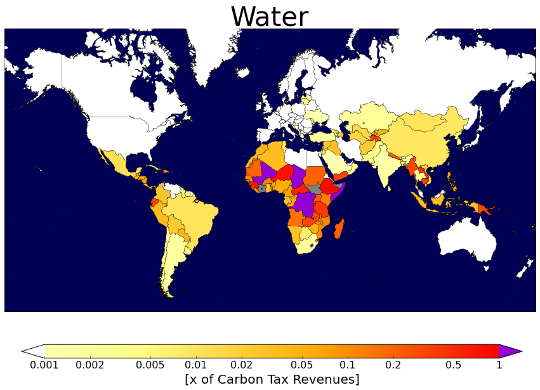15 April 2016
Drinking water: Carbon pricing revenues could close infrastructure gaps
A tax on CO2 emissions could make it possible to finance the drinking water supply in the majority of countries worldwide by the year 2030, according to a new study by researchers at the Mercator Research Institute on Global Commons and Climate Change (MCC) and the International Institute for Applied Systems Analysis (IIASA).
In India alone, a carbon tax would generate around 115 billion US$ a year, and only a fraction of that would be needed for clean water, meaning that enough money would remain for sanitation and electricity, the study shows. In fact, the needed infrastructure for water, sanitation, and electricity in this second largest country in the world would each consume only about 4% of the revenue raised by the tax in the country.
However the study also shows there are a few countries, especially in sub-Saharan Africa, where carbon pricing would not suffice, because carbon emissions there are so low that they would yield little revenue. “However, this funding gap could be closed when considering that developing countries have not yet exhausted their right to use the atmosphere,” says MCC researcher Michael Jacob, lead author of the study. “Avoidance of emissions would then entitle them to compensation payments from industrialized countries.”

Figure: Share of carbon pricing revenues required to finance universal access to water infrastructure under domestic carbon pricing (i.e., without transfers between countries) for an average 2°C scenario. The darker the color, the higher the share, with dark purple shares exceeding 100%. White areas denote countries for which data are not available. Please note the logarithmic scale.
The study, which examined the development potential for not only water, sanitation and electricity but also information technology and roads, was published today in the journal World Development. In their calculations, the researchers assume that every country in the world is now introducing a steadily increasing carbon tax. In 2020 the tax would have to be $40 per ton of CO₂ emissions and increase up to $175 by 2030.
“In addition to generating revenue for infrastructure, the tax would thus contribute to the international goal of limiting global warming to two degrees,” explains Sabine Fuss, a researcher at MCC and IIASA and a co-author of the study. “This is because the tax penalizes the use of fossil fuels and creates incentives for zero-carbon technologies.” Money not needed for the infrastructure could be used to mitigate climate change impacts such as rising sea levels, which affect in particular the developing countries.
As is well known, raising the price of coal, oil, and gas as part of climate protection measures brings its share of problems. Linking the revenue to a specific use, however, could increase acceptance among the population and decreases the risk of misappropriation. In addition, carbon pricing could be used to reduce the burdens facing in particular the poorer segments of the population, such as the value added tax.
IIASA researchers Sabine Fuss and Narasimha Rao contributed to the study.
Reference
Jakob M, Chen C, Fuss S, Marxen A.; Rao N,Edenhofer O. (2016) Carbon pricing revenues could close infrastructure gaps. World Development, http://dx.doi.org/10.1016/j.worlddev.2016.03.001
RESEARCH PARTNERS


